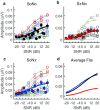Neural Correlates of the Binaural Masking Level Difference in Human Frequency-Following Responses
- PMID: 27896486
- PMCID: PMC5352611
- DOI: 10.1007/s10162-016-0603-7
Neural Correlates of the Binaural Masking Level Difference in Human Frequency-Following Responses
Abstract
The binaural masking level difference (BMLD) is an auditory phenomenon where binaural tone-in-noise detection is improved when the phase of either signal or noise is inverted in one of the ears (SπNo or SoNπ, respectively), relative to detection when signal and noise are in identical phase at each ear (SoNo). Processing related to BMLDs and interaural time differences has been confirmed in the auditory brainstem of non-human mammals; in the human auditory brainstem, phase-locked neural responses elicited by BMLD stimuli have not been systematically examined across signal-to-noise ratio. Behavioral and physiological testing was performed in three binaural stimulus conditions: SoNo, SπNo, and SoNπ. BMLDs at 500 Hz were obtained from 14 young, normal-hearing adults (ages 21-26). Physiological BMLDs used the frequency-following response (FFR), a scalp-recorded auditory evoked potential dependent on sustained phase-locked neural activity; FFR tone-in-noise detection thresholds were used to calculate physiological BMLDs. FFR BMLDs were significantly smaller (poorer) than behavioral BMLDs, and FFR BMLDs did not reflect a physiological release from masking, on average. Raw FFR amplitude showed substantial reductions in the SπNo condition relative to SoNo and SoNπ conditions, consistent with negative effects of phase summation from left and right ear FFRs. FFR amplitude differences between stimulus conditions (e.g., SoNo amplitude-SπNo amplitude) were significantly predictive of behavioral SπNo BMLDs; individuals with larger amplitude differences had larger (better) behavioral B MLDs and individuals with smaller amplitude differences had smaller (poorer) behavioral B MLDs. These data indicate a role for sustained phase-locked neural activity in BMLDs of humans and are the first to show predictive relationships between behavioral BMLDs and human brainstem responses.
Keywords: auditory; binaural; binaural masking level difference; frequency-following response; neurophonic; phase locking.
Conflict of interest statement
Conflict of Interest
The authors declare that they have no conflict of interest.
Figures









References
-
- Ballachanda BB, Moushegian G. Frequency-following response: effects of interaural time and intensity differences. J Am Acad Audiol. 2000;11:1–11. - PubMed
MeSH terms
Grants and funding
LinkOut - more resources
Full Text Sources
Other Literature Sources
Research Materials
Miscellaneous

